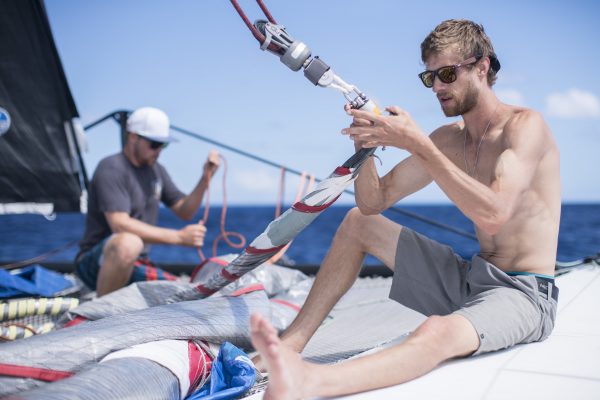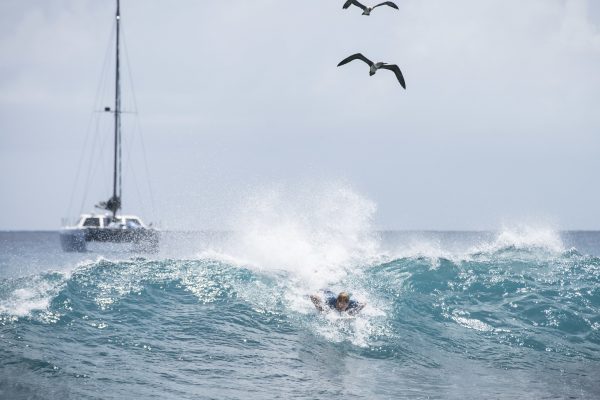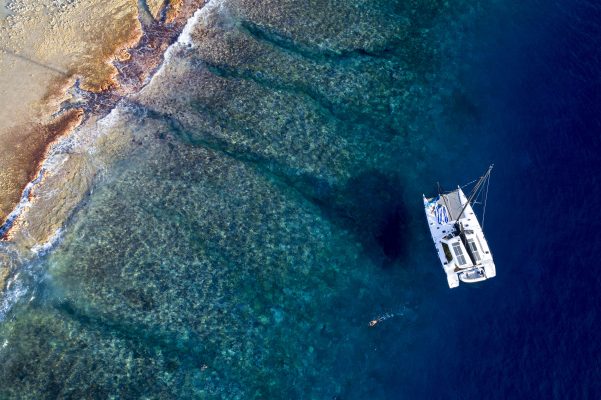Chasing the surf along the Pacific Line islands from Tahiti to Hawaii, Amory Ross enjoyed the trip of a lifetime
I could only laugh. Travis Rice, world-famous snowboarding pioneer, had just jumped into the Pacific waves to chase down his once-anchored dinghy, which was now floating away. Meanwhile Ian Walsh, professional big-wave surfer (and arguably one of the best ocean swimmers in the world), was nowhere to be found. He had gone investigating our abandoned island with Travis’s best friend, Graham Scott. I stood alone at the edge of the water, guiltily amused at our predicament.
We were effectively stranded on tiny Malden Island, 1,500 miles south of Hawaii and 1,000 miles north of Tahiti. Travis’ empty Gunboat 48, Falcor, lay anchored a few hundred yards off the beach after the four of us had gone ashore to explore, surf and fish. So impressed were we with Travis’ last catch, a fly-snared bonefish, that we completely missed the dinghy breaking free.
Its grey tubes were soon barely visible in the distance and I wondered how close it was to Travis’ limits as he swam away. Ian clearly wasn’t coming back anytime soon, so he didn’t have much of a choice.
Falcor had been based in Tahiti for the past three years. Travis had made the long journey from North Carolina to Tahiti via the Panama Canal as part of The Fourth Phase, a snowboarding movie made for his sponsors Red Bull on the hydrological cycle of water. Travis wanted to sail across the Pacific in the same air mass that would eventually hit the coast of Japan, where it would rise up the mountains to make the world-famous snow he’d ride back to the ocean. But first, Falcor needed to get to Hawaii and the Line Islands adventure was hatched.

All photos by ©Amory Ross
The Line Islands chain consists of 11 central Pacific atolls and coral islands formed by volcanic activity, stretching 1,500 miles from end to end. It is one of the longest island chains in the world and was the route that ancient Polynesians used to sail north to Hawaii. Using no instruments, they navigated without maps, compasses, or sextants, way-finding by observing only the ocean and the sky, the stars and the swells.
No stranger to Polynesian wayfinding and local ocean lore, Ian – a Maui native – was ticking two boxes on Falcor. As a new owner of a Hobie 16 he has joined a growing contingent of Hawaiian surfers that have adopted sailing. He was also scouting the region for future surf missions on the remote, unseen breaks along the way.
Winds were light as we left Pape’ete so we motored north, knowing the edge of the tradewinds was close. We passed Tetiaroa atoll, and its five-star resort founded by Marlon Brando, just 30 miles from Tahiti. With humpback whales playing in our wake, we kept going, anxious to leave the last reaches of first-world luxury behind.
Two days and 450 miles later we arrived at Flint Island. Flint was long, a narrow strip of rock covered with thick vegetation and nothing more. We sailed down its flank and dropped anchor off the north-west corner. The four of us donned snorkels to be greeted by an active and vibrant reef. Turtles were everywhere, as were sharks; French Polynesia’s oceans appeared well and healthy. Then with nightfall approaching we raised sails and plotted a course 550 miles north to Malden Island, our first planned stop and more importantly, first potential waves.

The Gunboat Falcor eating up the miles ©Amory Ross
Surfing at the helm
The sailing was nearly perfect. Consistent south-easterly tradewinds and large following seas had us comfortably averaging 22 knots. First-time helmsman Ian was brushing 30 knots, his wave-surfing principles translating seamlessly to the art of downwind planing.
I have spent plenty of time offshore going fast, but this was entirely different because we were essentially doing it in a very luxurious Winnebago. The helm felt balanced and light with very little lag between steering adjustments and rudder actions. Falcor seemed happiest at an apparent wind angle of 120°, where it was easy to turn up to load up some power, quickly accelerate, before tearing off across the face of the wave, bows free and clear from the water. I did this for hours, alone, with everyone else happily dreaming in their bunks, and absolutely no sail adjustments required.
That is the beauty of a lead-less, lightweight cruising cat: the acceleration is immediate and exhilarating, but the high roach main and self-tacking jib need little attention. We were cruising – but with such a competitive group it wasn’t long before we were all monitoring our top speeds and multi-hour-logs at each watch change.

The Gunboat 48 is the ideal owner-operator fast cat. Though its performance may intimidate, its relatively small size means an experienced boatowner is capable of running it alone, and Travis was no exception. The considerable freeboard is safe and dry and allows for ample headroom below. First-generation Gunboat bows, high and straight, provide bottomless storage for things like sails, dive gear and boards of all shapes and sizes.
Travis and Graham had made the previous crossing from Panama but had done little open water sailing since, and Ian had never been offshore on a sailboat, so we started in a two-watch system with Ian and myself on one, Travis and Graham the other.
The B&G instruments proved easy for the less experienced guys to learn and it wasn’t long before we moved to individual watches of three hours, with next-up on standby in the bunk, if needed.
On a dark, moonless night we arrived at Malden Island, and with little faith in the accuracy of our charts – the island’s radar signature and supposed position did not line up – we anchored conservatively, well outside the breaking waves that we could hear, but not see. We spent that night surveying the island virtually on Google Earth, Ian and Travis scrutinising every wave via satellite images.
After a calm morning at anchor and a three-course breakfast, the dinghy was launched and we turned for shore. Malden’s beaches were deep and clean, the island low and bare. A single tree stood above a calm spot as if to say ‘land here’. The waves down the line were big, surely overhead, and Travis dropped us off with the fishing gear before hurriedly taking the dinghy back outside the break to anchor.

At one point in time Malden was an active guano farm, inhabitants mining its land for the valuable fertiliser and transporting it using a sail-powered railroad system. Ian disappeared over the bluff intent on exploring the ruins while Graham and Travis started fishing.
Juvenile black tip sharks patrolled the shore, visible from the beach through crystal-clear walls of breaking waves, like a window into the sea. All was well in paradise. Until the dinghy broke free.
Miraculously, Travis reached it. I was kind of amazed. The shackle had come undone from the anchor so we somehow managed to find it, reattach and re-anchor. This time, we swam ashore with surfboards. After a good laugh at our own expense Ian and Travis surfed until they could paddle no more – possibly the very first time anyone had ever surfed Malden. It was pure, remote bliss.
Surfing at the helm
The next day we resumed our northerly progress and set our sights on Kiribati, some 430 miles away at 1°N. I knew before we left that both Travis and Graham were certified ‘Shellbacks’, trusty aids to King Neptune and sailors of proven seaworthiness, having previously crossed the Equator on Falcor in 2016. My own first Equator crossing came in 2011, on Puma for the Volvo Ocean Race. But this was Ian’s first crossing and he was due for a king’s visit.
While researching the ceremony’s origins we learned that Ian would be joining an elite class of Shellback; a ‘Golden Shellback’ – awarded only to the sailor who first crosses the Equator at the International Dateline. So at 0°N and 156°W, Neptune clambered up the transom demanding Ian show his worthiness by consuming raw two-day-old fish from the fridge. It was a significant sacrifice for a guy who doesn’t like to eat fish, but he survived the encounter and we offered our thanks to the sea with a splash of good rum over the side.

Finding previously unsurfed breaks was a highlight of the trip for the pro surfers on the crew ©Amory Ross
Much as we would have enjoyed stepping ashore in Kiribati, there was no surf in sight and Ian had received word that the Fiji swell we were chasing was coming sooner than expected. Some 200 miles north was Fanning Island with its famed left-or-right wave, breaking on both sides of a deep manmade channel that gave surfers a choice of either direction. It was arguably the best chance for big waves on the trip and Travis and Ian had been salivating over Fanning’s promise since departure, so we pressed on.
Ten days after leaving Tahiti, Fanning’s trees broke the horizon. Approaching the channel, waves peeled off to both sides and it wasn’t long after we had settled into the atoll’s shallow interior that Travis and Ian were clammering for their gear. They surfed the channel, cut during World War 1 almost until it was dark.
The next day we went ashore to clear customs, since we were now technically in the Kiribati Republic, and explore the island’s colourful shores.

The team took samples for water quality and pollution analysis along the way ©Amory Ross
During the war, Fanning had been home to a British cable relay station and its dredged entrance was a popular safe harbour for visiting warships. Today, Fanning looks like a shell of its one-time splendour, the overgrown landscape littered with abandoned buildings and deteriorating infrastructure. The USA’s Passenger Services Act of 1886 prohibited foreign ships from travelling between United States ports unless they stopped in a foreign country in between, so any foreign-flagged cruise ship leaving Hawaii used to stop at Fanning Island – the closest foreign port – and Fanning became accustomed to more than 200,000 day-trippers a year. That Act has been relaxed and those ships no longer stop at Fanning, so the atoll has since receded into relative poverty.
The customs agents were not at the office so we arranged for them to visit Falcor later that evening. When the time came we ferried them out so they could collect payment and conduct their search of the yacht. Alcohol is banned on Fanning but we were warned of the agents’ interest in ‘confiscating’ it, so we hid as much as we could. They found a stash of beer in the fridge and insisted we share – so they enjoyed several each, before we strongly suggested their time aboard was over. We returned the favour by unknowingly breaking the law of the land with the 12 coconuts we collected the following day from the vacant north shore. The meat and water was sweeter than any coconut anyone had ever had, but we later learned it is forbidden to cut down coconuts on Fanning.

The following day, a young local boy swam out into the surf to join us – grabbing a slippery 1980s-era board from the tree where it had leaned, presumably for decades. After a few unsuccessful attempts at standing up, Ian brought him over to the dinghy to wax his board. The boy eventually surfed and stayed out with us almost all day. When it was time to go home, Ian gave him his leash and remaining wax, then Travis went ashore with a brand new surfboard to leave behind for the next generation of aspiring island surfers.
Jaws beckons
Our final passage was to be the longest, with 1,200 miles of open ocean between Fanning and Honolulu. It was hurricane season in the North Pacific and we would also transit the Inter Tropical Convergence Zone, where the trade winds of the northern and southern hemispheres collide. The region is characterised by volatile, unpredictable weather and energetic thunderstorms, as well as large expanses of little-to-no wind.
It was a welcome return to the open ocean after a few busy days at anchor. We settled back into our offshore routines and again revelled in the quiet solitude that can only really be found at sea. We practiced with our sextant, studied the night-time stars and anxiously counted down the dwindling mileage until we knew our adventure would be over.
It’s hard not to fall in love with 21st century catamaran cruising. In addition to making passagemaking fun and fast, cats like Falcor are very capable of covering long distances with a literal boatload of toys and amenities. I will always remember the awe of that first night, sitting behind the helm at 0200 in a perfectly flat director’s chair, a hot cup of proper coffee in one hand and a good book in the other, surfing across the Pacific at 23 knots.

LIFE ON THE OCEAN
One month after the trip, Ian Walsh went on to win the World Surf League’s Pe’ahi Challenge at Jaws with a ‘perfect 10’ wave.
He told me afterwards that after the voyage not only did he feel physically well enough to surf Jaws despite the break in training, but that he felt mentally refreshed. The 20 days away from digital distractions had given him a rare focus and, interestingly, the surfing press were onto it too. He was asked if the time at sea left his body more ‘in tune with the waves’, as people noted a perceptible change in his surfing.
Falcor has since changed hands and is now owned by two-time Surfing World Champion John John Florence.
ABOUT THE AUTHOR
An on board reporter on three Volvo Ocean Races, AMORY ROSS has spent more than a decade in the world of grand prix sailing and worked with two America’s Cup teams, but his very first published was Yachting World in 2006.




